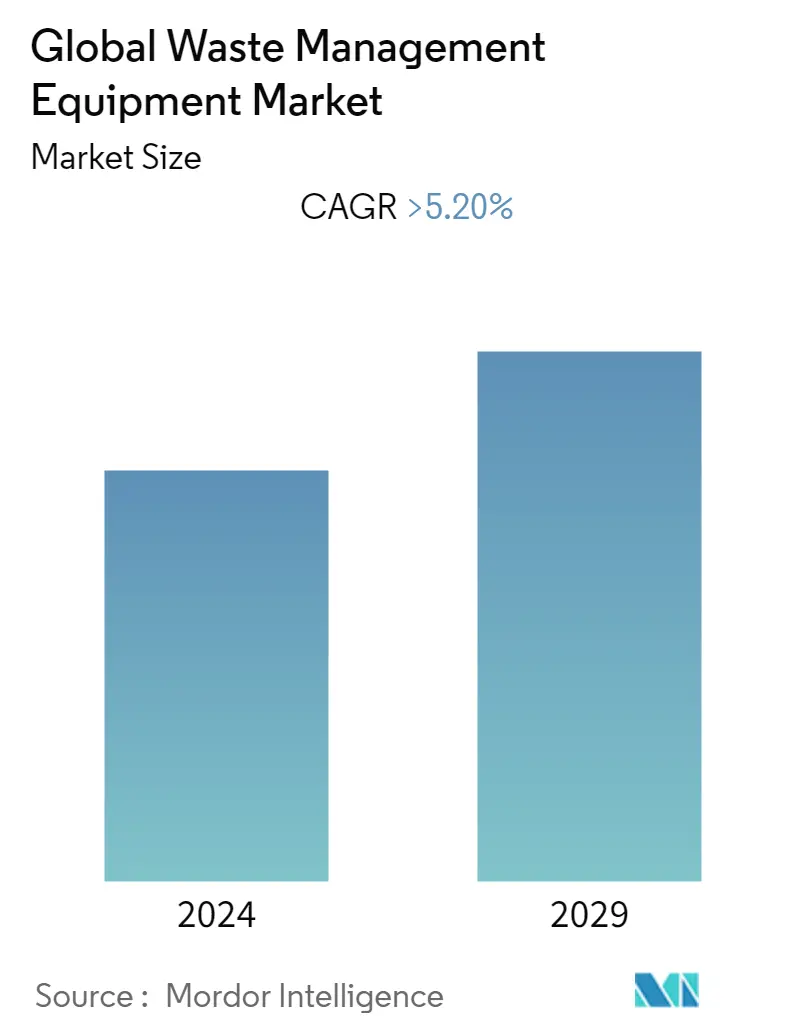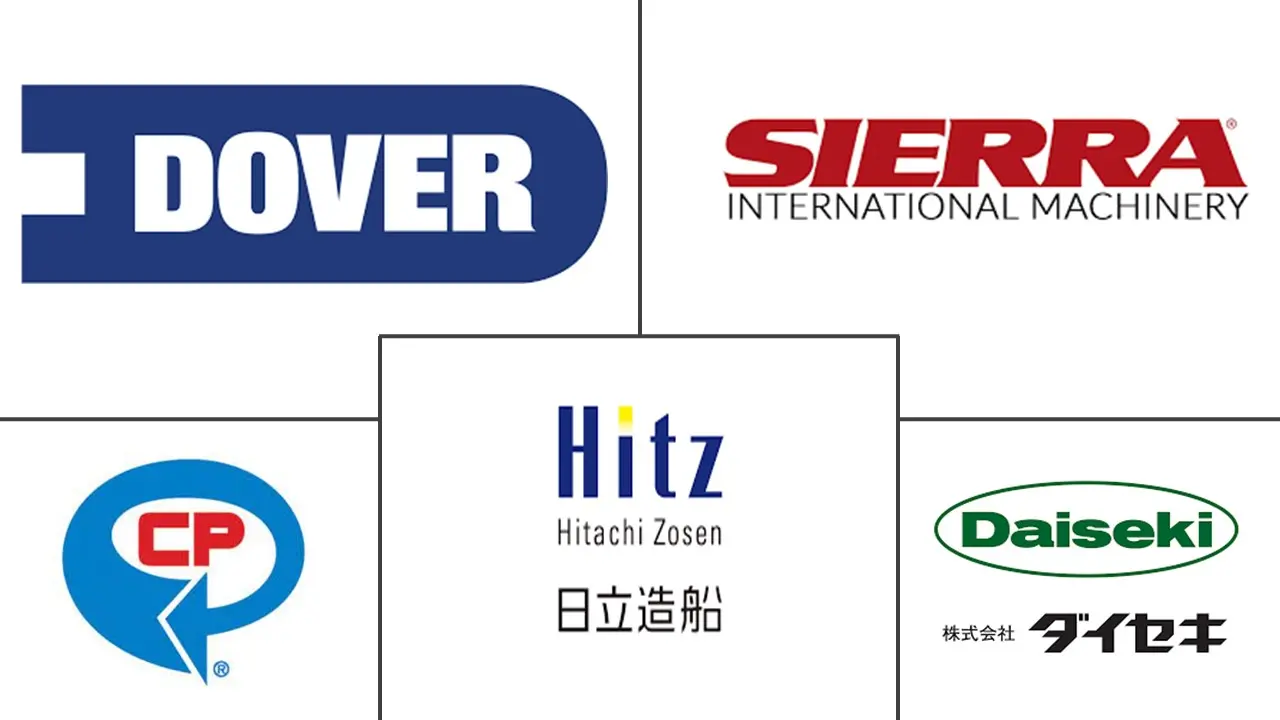Market Size of Global Waste Management Equipment Industry

| Study Period | 2020 - 2029 |
| Base Year For Estimation | 2023 |
| CAGR | > 5.20 % |
| Fastest Growing Market | Asia-Pacific |
| Largest Market | North America |
| Market Concentration | Medium |
Major Players
*Disclaimer: Major Players sorted in no particular order |
Waste Management Equipment Market Analysis
The Global waste management equipment market is expected to record a CAGR of more than 5.2% during the forecast period, 2022-2027.
COVID-19 impacted the waste management industry from the focus of segment shift; during the lockdown, the residential segment generated more waste than industrial and commercial centres, as industries and offices were partially or completely shut. Industrial and commercial waste production fell drastically due to the slowdown in manufacturing activity. Hazardous waste production grew with higher production from the pharmaceutical and medical sectors. The COVID-19 pandemic triggered a zero-waste approach that requires members of the EU to recycle waste between 70-80% while declining GHG emissions attributed to toxic waste disposal and incineration techniques as per the European Commission.
Existing hazardous waste treatment capacity in developing countries was overwhelmed, leading to stockpiling and potentially inadequate disposal. Municipal waste had increased in volume, effectively overwhelming existing waste collection and disposal systems. A reduction in recycling activities was reported which further compounded challenges in the collection and disposal of municipal waste. The study conducted by AMSA Group in 2020 states that in Milan (Italy), the institution of strict lockdown led to a decline in the total waste production by 27.5%. However, recycling of waste increased by 1% compared to 2019 the same period, whereas street bins declined by 38.2%. The month of confinement saw a 16.65% drop in municipal waste.
According to the World Bank, by 2050, waste production will be 73% higher than in 2020. This increase will be mostly driven by middle-income countries in which waste generation will nearly double in the next three decades, though low- and many- high-income countries will contribute significantly to the growing volume. As of 2021, only 77% of global solid waste is collected and 33% of it is openly dumped. The situation in low-income countries is particularly alarming, where only 40% of the generated waste is collected and 93% is dumped or improperly managed. A survey conducted by the Institute of Scrap Recycling Industries (ISRI) in 2021 suggests that 66% of Americans would not recycle a product if it's not easy or inconvenient to do so, and the municipal solid waste (MSW) recycling rate in the US remains as low as 35% in the country. As per National Environment Agency (NEA), Singapore, in 2021, about 6.94 million tonnes of solid waste was generated, of which 3.83 million tonnes were recycled. Waste generated by the non-domestic and domestic sectors both increased in 2021, from 4.12 million tonnes and 1.77 million tonnes respectively in 2020, to 5.12 million tonnes and 1.82 million tonnes respectively in 2021, recycled waste attributed to the non-domestic and domestic sectors likewise increased, from 2.81 million tonnes and 0.23 million tonnes respectively in 2020, to 3.58 million tonnes and 0.24 million tonnes respectively in 2021 in Singapore. Thus increasing awareness about proper recycling and disposal of waste is fueling the growth of waste management industry.
Waste Management Equipment Industry Segmentation
The waste management equipment involves collecting solid, liquid, and gas waste. This includes the activities and actions required to manage waste from its inception to the final stage of disposal. This comprises of collection, transport, treatment, and disposal of waste coupled with monitoring and regulation of the waste management process. A complete background analysis of the Global waste management equipment market, including the assessment of the economy and contribution of sectors in the economy, market overview, market size estimation for key segments, and emerging trends in the market segments, market dynamics, and geographical trends, and COVID-19 impact is included in the report.
The Global Waste Management Equipment Market is segmented By Product Type, (Waste Disposal Equipment and Waste Recycling & Sorting Equipment), By Waste Type (Hazardous and Non-hazardous), By Application (Industrial Waste, Municipal Waste, and Others), and By Geography (North America (US, Canada, Mexico), Europe (Spain, Germany, France, UK, Portugal, Greece, Italy, rest of Europe), Asia-Pacific (China, Japan, South Korea, India, rest of Asia-Pacific), LAMEA (UAE, Saudi Arabia, Brazil, South Africa, rest of LAMEA)). The report offers market size and forecasts in values (USD billion) for all the above segments.
| By Product Type | |
| Waste Disposal Equipment | |
| Waste Recycling & Sorting Equipment |
| By Waste Type | |
| Hazardous | |
| Non-Hazardous |
| By Application | |
| Industrial Waste | |
| Municipal Waste | |
| Others |
| By Geography | ||||||||||
| ||||||||||
| ||||||||||
| ||||||||||
|
Global Waste Management Equipment Market Size Summary
The global waste management equipment market is poised for significant growth, driven by increasing awareness and regulatory pressures surrounding waste reduction, recycling, and proper disposal methods. The market landscape is characterized by a high level of competition, with established players and emerging startups focusing on innovative technologies to enhance recycling and waste management processes. The COVID-19 pandemic has highlighted the vulnerabilities in waste management systems, with a shift in waste generation patterns and an increase in single-use plastics and PPE waste. This has underscored the need for more robust waste management solutions and has accelerated the adoption of a zero-waste approach in various regions, particularly in the European Union.
Market dynamics are influenced by the growing volume of waste, particularly in middle-income countries, and the challenges faced in developing regions where waste collection and recycling rates remain low. The global market is witnessing strategic expansions and investments, as companies like Sierra International Machinery and Umicore enhance their production capacities and focus on recycling initiatives. The emphasis on the 3R philosophy (Reduce, Reuse, Recycle) is driving mergers and acquisitions, as well as the development of new technologies aimed at improving waste management efficiency. As the demand for sustainable waste management solutions continues to rise, the market is expected to expand, offering opportunities for innovation and growth across the globe.
Global Waste Management Equipment Market Size - Table of Contents
-
1. MARKET INSIGHTS DYNAMICS
-
1.1 Current Market Scenario
-
1.2 Market Overview
-
1.3 Market Dynamics
-
1.3.1 Drivers
-
1.3.2 Restraints
-
1.3.3 Opportunities
-
-
1.4 Value Chain / Supply Chain Analysis
-
1.5 Porter's Five Forces Analysis
-
1.5.1 Threat of New Entrants
-
1.5.2 Bargaining Power of Buyers/Consumers
-
1.5.3 Bargaining Power of Suppliers
-
1.5.4 Threat of Substitute Products
-
1.5.5 Intensity of Competitive Rivalry
-
-
1.6 Technological Advancements in Waste Management Equipment Market
-
1.7 Regional insights on Waste Management Equipment Market
-
1.8 Impact of COVID-19 on the market
-
-
2. MARKET SEGMENTATION
-
2.1 By Product Type
-
2.1.1 Waste Disposal Equipment
-
2.1.2 Waste Recycling & Sorting Equipment
-
-
2.2 By Waste Type
-
2.2.1 Hazardous
-
2.2.2 Non-Hazardous
-
-
2.3 By Application
-
2.3.1 Industrial Waste
-
2.3.2 Municipal Waste
-
2.3.3 Others
-
-
2.4 By Geography
-
2.4.1 North America
-
2.4.1.1 US
-
2.4.1.2 Canada
-
2.4.1.3 Mexico
-
-
2.4.2 Europe
-
2.4.2.1 Spain
-
2.4.2.2 Germany
-
2.4.2.3 France
-
2.4.2.4 UK
-
2.4.2.5 Portugal
-
2.4.2.6 Greece
-
2.4.2.7 Italy
-
2.4.2.8 Rest of Europe
-
-
2.4.3 Asia-Pacific
-
2.4.3.1 China
-
2.4.3.2 Japan
-
2.4.3.3 South Korea
-
2.4.3.4 India
-
2.4.3.5 Rest of Asia-Pacific
-
-
2.4.4 LAMEA
-
2.4.4.1 UAE
-
2.4.4.2 Saudi Arabia
-
2.4.4.3 Brazil
-
2.4.4.4 South Africa
-
2.4.4.5 Rest of LAMEA
-
-
-
Global Waste Management Equipment Market Size FAQs
What is the current Global Waste Management Equipment Market size?
The Global Waste Management Equipment Market is projected to register a CAGR of greater than 5.20% during the forecast period (2024-2029)
Who are the key players in Global Waste Management Equipment Market?
Sierra International Machinery, LLC, CP Manufacturing, Inc., Dover Corporation, Daiseki and Hitachi Zosen are the major companies operating in the Global Waste Management Equipment Market.

